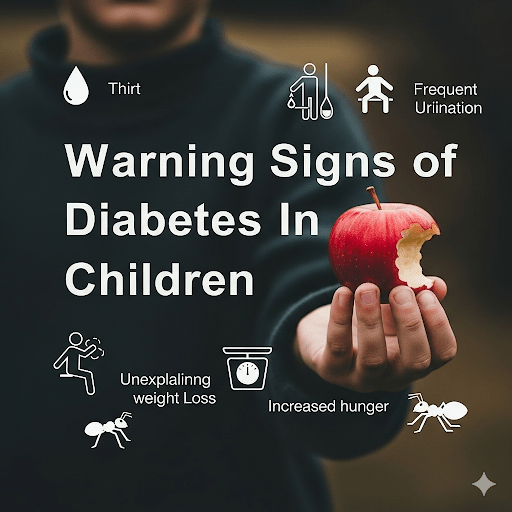Urgent Alert: Warning Signs of Diabetes in Children Every Parent Needs to Know
Meta Description:
Worried about your child’s health? Learn to spot the subtle and obvious warning signs of diabetes in children and discover what to do next. Early detection is key.
Table of Contents
Urgent Alert: Warning Signs of Diabetes in Children Every Parent Needs to Know
As a parent, your child’s health is your number one priority. But what if a common complaint—like being thirsty—is actually a sign of something more serious? The symptoms of diabetes in children can often be mistaken for other illnesses, growth spurts, or just normal childhood behavior. This can lead to delays in diagnosis, which can be dangerous.
This post is a lifeline, designed to empower you with the critical knowledge to recognize the warning signs of diabetes in children. We will address the fears and uncertainties that come with a potential diagnosis, giving you a clear, actionable guide to take control.
Your goal is to be a vigilant protector of your child’s well-being, and by the end of this post, you’ll be able to confidently identify the symptoms and know exactly what steps to take next. The transformation is simple yet profound: to move from a place of uncertainty to one of informed proactivity, ready to act if you ever need to.

The Big Four: Recognizing the Primary Warning Signs Of Diabetes In Children
The most common signs of diabetes in children often present as a group. While one symptom alone might not seem like a red flag, a combination of these “Big Four” should prompt a call to your pediatrician immediately.
- Increased Thirst (Polydipsia): Is your child suddenly and constantly thirsty, no matter how much they drink? Are they waking up in the middle of the night to get a drink? This is one of the most classic signs, as the body tries to dilute the high sugar in the bloodstream.
- Frequent Urination (Polyuria): High blood sugar pulls fluid from the tissues, causing the kidneys to work overtime to filter it out. This results in more frequent trips to the bathroom. You might notice bedwetting in a child who was previously potty trained, or they may need to use the bathroom more often during the day.
- Extreme Hunger (Polyphagia): Despite eating more, your child may seem constantly hungry. This is because their body’s cells aren’t getting the glucose they need for energy, so the brain sends signals to eat more.
- Unexplained Weight Loss: This is a major red flag. Despite a constant or increased appetite, your child may be losing weight. This is because their body is breaking down muscle and fat for energy since it cannot use glucose properly.
Warning Signs Of Diabetes In Children
- Increased Thirst (Polydipsia).
- Frequent Urination (Polyuria)
- Extreme Hunger (Polyphagia):
- Unexplained Weight Loss:

The Other, More Subtle Warning Signs Of Diabetes In Children To Watch For
Beyond the “Big Four,” there are other signs that can indicate a problem. Paying attention to these can lead to an even earlier diagnosis.
- Fatigue: Is your child unusually tired or lethargic? They may have a lack of energy for activities they normally love, as their body can’t convert glucose into usable energy.
- Blurry Vision: High blood sugar can pull fluid from the lenses of the eyes, affecting a child’s ability to focus.
- Fruity Breath Odor: In severe, undiagnosed cases, the body will start to burn fat for fuel, producing ketones. High levels of ketones can cause a sweet, fruity smell on your child’s breath, similar to nail polish remover. This is a sign of a dangerous condition called diabetic ketoacidosis (DKA) and requires immediate medical attention.
A Relatable Example: Putting the Pieces Together
Consider a parent who notices their eight-year-old daughter is suddenly complaining of being tired after school and constantly asking for drinks. The parent initially assumes it’s due to a growth spurt or the weather. Then, they start to notice her making more trips to the bathroom, even at night. On the scale, she has lost a few pounds despite a healthy appetite.
Individually, these symptoms seem minor. But when the parent steps back and sees them all together—the thirst, urination, fatigue, and weight loss—they realize something is wrong. This realization prompts them to call their doctor, leading to a quick diagnosis and the beginning of a management plan that prevents a medical emergency.
Concluding FAQ About Warning Signs Of Diabetes In Children
Q1: Can a child get diabetes suddenly?
The onset of Type 1 diabetes can be very rapid, sometimes occurring over just a few weeks or even days. Symptoms can quickly escalate, which is why recognizing them early is so important.
Q2: What is diabetic ketoacidosis (DKA)?
DKA is a serious, life-threatening complication of diabetes. It happens when the body doesn’t have enough insulin to allow blood sugar into the cells for energy. The body then begins to burn fat for fuel, which produces ketones. High levels of ketones are toxic and can cause the blood to become dangerously acidic. DKA requires immediate emergency medical care.
Q3: Can a child outgrow diabetes?
Children with Type 1 diabetes cannot outgrow the condition. It is a lifelong, chronic autoimmune disease. However, with Type 2 diabetes, which is much less common in children, remission is possible with significant lifestyle changes, though it still requires lifelong management.
References
American Diabetes Association. (2024). Type 1 diabetes in children. https://www.diabetes.org/diabetes/type-1/type-1-in-children
Centers for Disease Control and Prevention. (2023). Type 1 diabetes: Symptoms, causes, and treatment. https://www.cdc.gov/diabetes/basics/type1.html
Joslin Diabetes Center. (2024). Signs and symptoms of type 1 diabetes in children. https://www.joslin.org/patient-care/programs-and-services/pediatric-diabetes/symptoms-and-diagnosis
The Mayo Clinic. (2023). Diabetes symptoms in children. https://www.mayoclinic.org/diseases-conditions/diabetes-in-children/symptoms-causes/syc-20355311